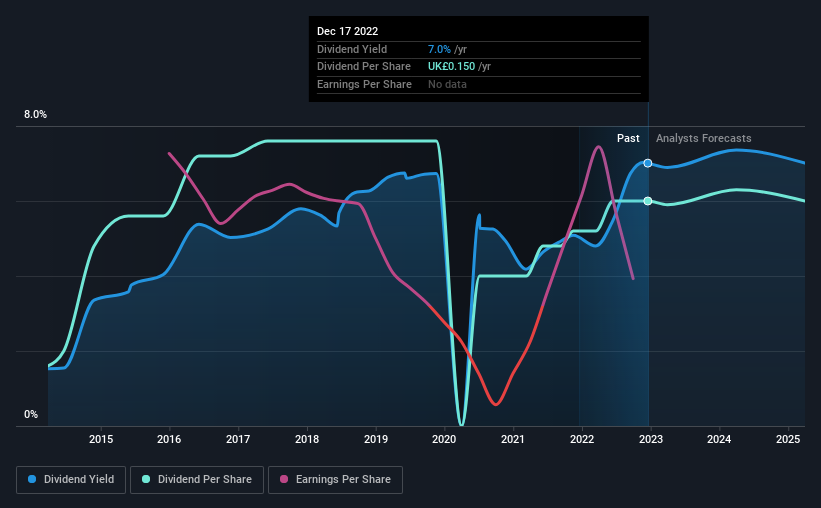We Wouldn't Be Too Quick To Buy Palace Capital Plc (LON:PCA) Before It Goes Ex-Dividend
Regular readers will know that we love our dividends at Simply Wall St, which is why it's exciting to see Palace Capital Plc (LON:PCA) is about to trade ex-dividend in the next three days. The ex-dividend date is one business day before a company's record date, which is the date on which the company determines which shareholders are entitled to receive a dividend. The ex-dividend date is important because any transaction on a stock needs to have been settled before the record date in order to be eligible for a dividend. In other words, investors can purchase Palace Capital's shares before the 22nd of December in order to be eligible for the dividend, which will be paid on the 13th of January.
The company's upcoming dividend is UK£0.037 a share, following on from the last 12 months, when the company distributed a total of UK£0.15 per share to shareholders. Last year's total dividend payments show that Palace Capital has a trailing yield of 7.0% on the current share price of £2.14. If you buy this business for its dividend, you should have an idea of whether Palace Capital's dividend is reliable and sustainable. That's why we should always check whether the dividend payments appear sustainable, and if the company is growing.
Check out our latest analysis for Palace Capital
Dividends are typically paid out of company income, so if a company pays out more than it earned, its dividend is usually at a higher risk of being cut. Palace Capital distributed an unsustainably high 159% of its profit as dividends to shareholders last year. Without more sustainable payment behaviour, the dividend looks precarious. Yet cash flows are even more important than profits for assessing a dividend, so we need to see if the company generated enough cash to pay its distribution. It distributed 34% of its free cash flow as dividends, a comfortable payout level for most companies.
It's good to see that while Palace Capital's dividends were not covered by profits, at least they are affordable from a cash perspective. If executives were to continue paying more in dividends than the company reported in profits, we'd view this as a warning sign. Extraordinarily few companies are capable of persistently paying a dividend that is greater than their profits.
Click here to see how much of its profit Palace Capital paid out over the last 12 months.
Have Earnings And Dividends Been Growing?
Companies with falling earnings are riskier for dividend shareholders. If earnings fall far enough, the company could be forced to cut its dividend. Palace Capital's earnings per share have fallen at approximately 24% a year over the previous five years. Such a sharp decline casts doubt on the future sustainability of the dividend.
Another key way to measure a company's dividend prospects is by measuring its historical rate of dividend growth. In the last nine years, Palace Capital has lifted its dividend by approximately 16% a year on average. That's intriguing, but the combination of growing dividends despite declining earnings can typically only be achieved by paying out a larger percentage of profits. Palace Capital is already paying out 159% of its profits, and with shrinking earnings we think it's unlikely that this dividend will grow quickly in the future.
The Bottom Line
Is Palace Capital an attractive dividend stock, or better left on the shelf? It's not a great combination to see a company with earnings in decline and paying out 159% of its profits, which could imply the dividend may be at risk of being cut in the future. Yet cashflow was much stronger, which makes us wonder if there are some large timing issues in Palace Capital's cash flows, or perhaps the company has written down some assets aggressively, reducing its income. Overall it doesn't look like the most suitable dividend stock for a long-term buy and hold investor.
With that being said, if you're still considering Palace Capital as an investment, you'll find it beneficial to know what risks this stock is facing. For example, we've found 5 warning signs for Palace Capital (1 is a bit concerning!) that deserve your attention before investing in the shares.
A common investing mistake is buying the first interesting stock you see. Here you can find a full list of high-yield dividend stocks.
Have feedback on this article? Concerned about the content? Get in touch with us directly. Alternatively, email editorial-team (at) simplywallst.com.
This article by Simply Wall St is general in nature. We provide commentary based on historical data and analyst forecasts only using an unbiased methodology and our articles are not intended to be financial advice. It does not constitute a recommendation to buy or sell any stock, and does not take account of your objectives, or your financial situation. We aim to bring you long-term focused analysis driven by fundamental data. Note that our analysis may not factor in the latest price-sensitive company announcements or qualitative material. Simply Wall St has no position in any stocks mentioned.
Join A Paid User Research Session
You’ll receive a US$30 Amazon Gift card for 1 hour of your time while helping us build better investing tools for the individual investors like yourself. Sign up here

 Yahoo Finance
Yahoo Finance 
